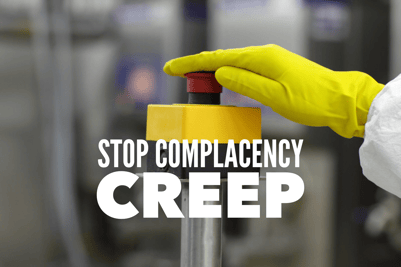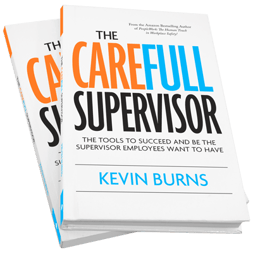Safety complacency is addressed at the ultra-local level; at the front-line. That’s where the complacency takes place. That’s where it gets fixed.
 Who could have ever foreseen that you could get so good at your work that complacency would become a safety issue? Safety processes and procedures are done so well that your crews have become exceptional safety performers. And because they do work they can be proud of, they take satisfaction in how well they do the job. That satisfaction can create complacency.
Who could have ever foreseen that you could get so good at your work that complacency would become a safety issue? Safety processes and procedures are done so well that your crews have become exceptional safety performers. And because they do work they can be proud of, they take satisfaction in how well they do the job. That satisfaction can create complacency.
It’s not your fault that you never saw it coming. You followed the processes and procedures, the rules and regulation so well that you got into the habit of always doing it well. They are not negative habits. They are the same positive habits that are creating a safety risk.
Consulting and speaking clients have discussed complacency-creep with me. They gush about their people, competent teams who do excellent work. But, niggling issues are starting to show up in the form of small mistakes, and memory and judgment lapses. They are afraid that the small issues have the potential to become more serious. That’s complacency-creep sneaking in.
The longer crews work on the job together, the more they get into a kind of rhythm working together. But that rhythm can become a routine. And where there is routine, there is rote: doing the job robotically. “Auto-pilot.”
Complacency is not something that is fixed or repaired or even addressed at the senior management level. Complacency is addressed at the ultra-local level; at the front-line between supervisor and employee. That’s where the complacency takes place. That’s where it gets fixed.
To effectively take on complacency-creep, here are four strategies to arrest it before it begins to creep in:
1Get everyone on it. Complacency takes a team effort to eradicate. If everyone believes in not getting hurt, then they have to do whatever is necessary to achieve that result. That means being focused on the warning signs that could lead to an incident. Get in front of complacency and lessen the likelihood of an incident. Besides physical hazards, you are looking for signs of complacency. They can happen through repetitive tasks, fatigue, rushing, etc. Get into the habit of shouting out “game on” (or some other rallying phrase of your choosing). Use them as reminders that the crew needs to get their heads in the game. Employees distracted or dulled (a cold, flu, low blood sugar, etc) need to be willing to be extra-vigilant.
2Safety marketing. When it comes to complacency, the message must be “our greatest threat is ourselves.” Processes and procedures take care of the vast majority of physical threats. What is left to address is the mental threat. You repeated process and procedure over and over again to get your crews to do it right physically. Now, repeat that rallying message that reminds them that they are at mental risk. Something that gets conscious attention and blocks them from going into unconscious auto-pilot. (There are two full chapters on safety marketing and how to put these campaigns together - including a step-by-step approach for your Joint Health & Safety Committee in my book, PeopleWork: The Human Touch in Workplace Safety.)
3Supervisors must connect. The supervisor is the first line of defense when it comes to complacency. The supervisor needs to know his or her people intimately. Supervisors must be able to tell when their people's minds are wandering. They need to be able to tell whether their crew members are distracted by a personal issue or a cold or the flu. Supervisors need to step in and double-check. Employees need to be truthful. If necessary, perhaps a teammate could work closely with the affected person. Supervisors must gain the trust of employees. Create a culture where employees can voluntarily admit that they are having trouble keeping mind on task.
4Targets and achievements. Nothing is quite as motivating as success. When employees succeed, they want to do it again. It feels good to succeed. Focused attention is greater during moments of success than in moments of mundane tasks. Setting up small achievable goals and targets to hit can build motivation to want to achieve more. Momentum is built when targets get knocked down and the team is moving forward. Set your targets in 2-hour increments. At break time, celebrate. The occasional box of donuts or coffee for the crews is a focusing and rewarding celebration. Sometimes, a heartfelt visit from management to offer congratulations can make a difference too.
 To win the battle, engage your crews to look for the signs of complacency. Task them with finding solutions to overcome it. Solutions developed at the front-line gets ownership by front-line crews. Something dictated from senior management may seem thrust upon them.
To win the battle, engage your crews to look for the signs of complacency. Task them with finding solutions to overcome it. Solutions developed at the front-line gets ownership by front-line crews. Something dictated from senior management may seem thrust upon them.
Complacency creep is insidious. But if you’re looking for it, and the crews are looking for it, and you’re all working together to eliminate it, complacency doesn’t stand a chance.
Kevin Burns has authored ten books on human performance and safety, including his most recent release, PeopleWork - The Human Touch in Workplace Safety. Buy it now on Amazon. Then, consider bringing Kevin's consulting expertise to your company or have him speak at a safety event.
©2017 ZeroSpeak Corporation and Kevin Burns.
No part of this post may be reproduced without the expressed consent of the author.


